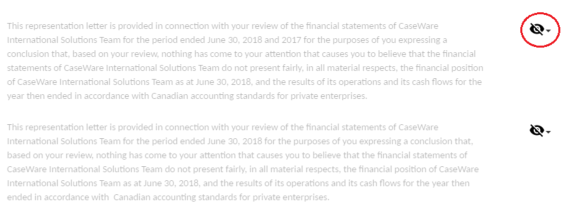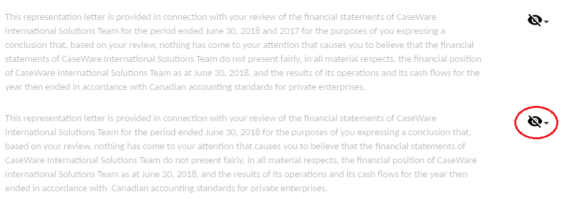Novedades - ReviewComp Winter 2019 (v1.2106.0)
Este es un listado de las novedades de la versión de febrero de 2019 de OnPoint PCR.
Certificación del impuesto de sociedades
Caseware ReviewComp ha sido certificada para la preparación de declaraciones de impuestos federales T2 y de la AT1 de Alberta para incluir corporaciones con fechas de cierre de año hasta el 31 de octubre de 2019.
Rediseño de las funciones de consulta
Hemos lanzado el nuevo diseño de interfaz de usuario para documentos de consulta en Caseware ReviewComp.
La nueva interfaz se centra en potenciar el estilo y el atractivo visual, mejorar la usabilidad, optimizar la disposición y organización de los componentes, así como utilizar términos claros y sencillos.
He aquí un rápido vistazo a las principales características.
-
Cambios de plazo.
-
Consulta : anteriormente se utilizaba para referirse al documento y a las preguntas del documento. En la nueva interfaz, el término Consulta sólo se refiere al documento. Mientras que Consulta Pregunta se refiere ahora a las preguntas/solicitudes/inquietudes del documento.
-
Conjunto de preguntas : sustituye al término Grupo.
-
-
Tarjetas de preguntas con el título y el cuerpo de la pregunta, la respuesta y los comentarios.
-
El panel de navegación también cuenta con una única acción de seleccionar y arrastrar.
-
Un método más sencillo para añadir preguntas de consulta.
Con las tarjetas de preguntas, puede detectar e identificar fácilmente los elementos que pertenecen a la misma pregunta.
Un panel de navegación lateral, donde puede ver y desplazarse por todas las preguntas de consulta disponibles agrupadas por conjunto de preguntas.
Ahora puede reorganizar fácilmente los conjuntos de preguntas y las preguntas de consulta.
A continuación, seleccione el tipo de respuesta deseado al añadir la pregunta de consulta en el documento. Ya no es necesario acceder al cuadro de diálogo de configuración para añadir o modificar un tipo de respuesta.
Para obtener más información, consulte Colaboración personal-contacto (antiguo diseño de consulta).
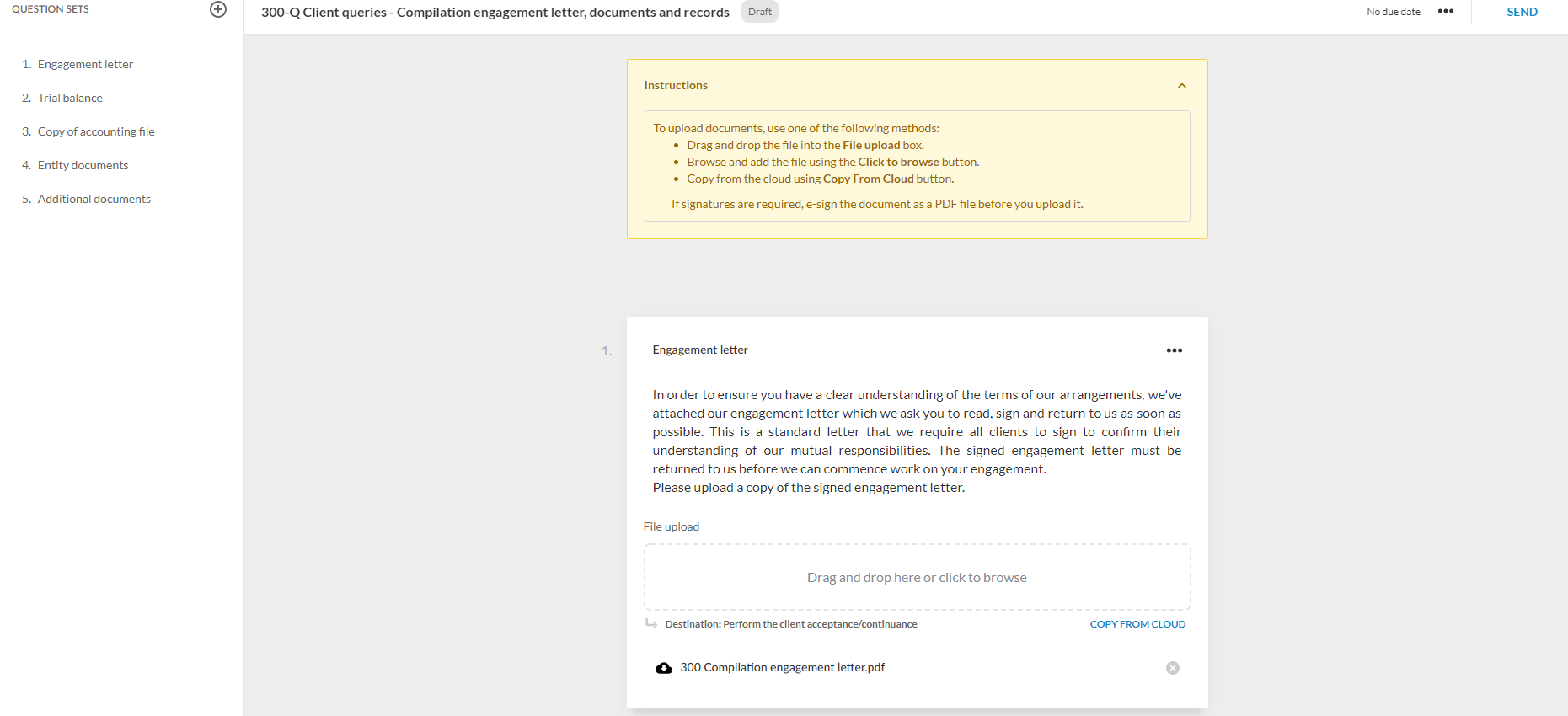
La página de Balance de Sumas y Saldos es ahora la Página de Datos
Hemos lanzado la página Datos en Caseware ReviewComp. La página Datos sustituye a la página Balance de Sumas y Saldos. Ofrece una interfaz de usuario mejorada y nuevas funciones:
- Importación de transacciones.
- Desglose desde las cuentas hasta los detalles de las transacciones.
- Panel izquierdo para cambiar fácilmente entre las distintas opciones de visualización (cuentas, grupos financieros y grupos fiscales).
- Clasificación y filtrado de datos dentro de cada vista.
- Capacidad de búsqueda.
- Ahora los usuarios pueden exportar los ajustes a un archivo CSV, a un PDF o a documentos de trabajo (formato CSV ASCII).
Para obtener más información, consulte los temas de ayuda sobre cómo importar datos de balances de sumas y saldos y transacciones, así como sobre cómo visualizar cuentas, grupos y datos transaccionales .
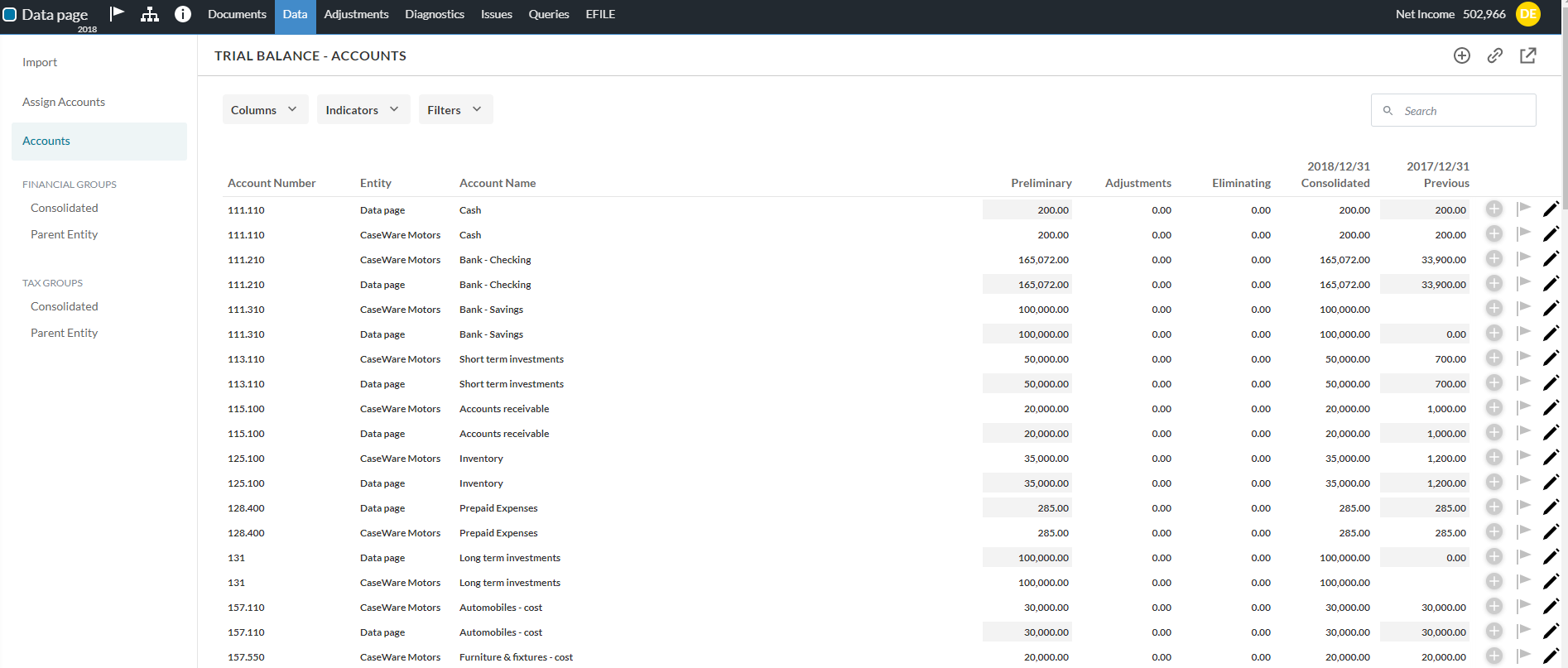
Consolidated Financial Statements
Caseware ReviewComp ahora admite escenarios de consolidación de entidades. El botón Consolidar está ahora disponible en el cuadro de diálogo Propiedades de la operación para permitirle añadir filiales a la entidad y definir la relación de consolidación. Los datos del balance de sumas y saldos muestran automáticamente el balance matriz-filial (también conocido como balance consolidado) una vez creada la relación de consolidación.
Para obtener más información, consulte Creación de un encargo de consolidación y Visualización de los datos de los encargos de consolidación.
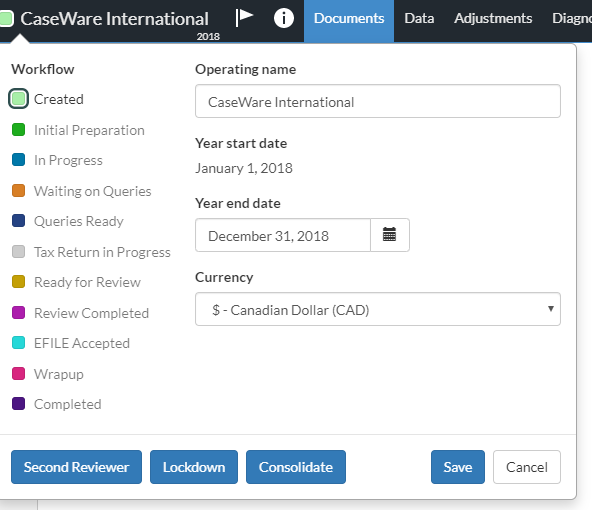
Ajustes
Ahora los usuarios pueden exportar los ajustes a un archivo CSV, a un PDF o a documentos de trabajo (formato CSV ASCII).
Para más información, consulte Añadir zonas.
Mejoras en el documento de estados financieros
Esta versión incorpora una serie de mejoras en los ámbitos de la conciliación, las relaciones de redondeo, las tablas dinámicas, los marcadores de texto/campos y las herramientas de revisión.
Conciliación
Ahora puede detectar fácilmente los registros que no concuerdan entre sí para identificar las discrepancias de saldo y ayudarle a elaborar estados financieros fiables, precisos y de alta calidad.
Aparece un icono junto a cada saldo de cuenta con discrepancias identificadas. Si selecciona el icono, aparece una ventana emergente que muestra los detalles de las discrepancias (nombres de las cuentas y saldos).
Ahora los usuarios pueden anular los saldos de cuentas procedentes del balance de sumas y saldos en tablas dinámicas. Los cambios se reflejan automáticamente en todas las tablas del documento, así como en las determinaciones de desviaciones (si están disponibles). Para los saldos anulados, la ventana emergente de detalles de la cuenta muestra el saldo anulado e incluye una línea adicional que muestra el saldo original.
Para obtener más información, consulte Ver discrepancias de saldos en los estados financieros y Anular saldos en los estados financieros.
Redondeo
Ahora puede seleccionar el grupo financiero al que desea que se apliquen las diferencias de redondeo. Una vez seleccionadas, todas las diferencias de redondeo se suman al total del grupo. En la ventana emergente de detalles de la cuenta, aparece una línea adicional que muestra los detalles del redondeo.
Para obtener más información, consulte los temas de ayuda sobre redondeo en losestados financieros, redondeo y arrastre y cómo ver los detalles de redondeo en los estados financieros.
Herramientas de revisión
El icono del filtro ya no está disponible. Una vez que los usuarios seleccionan el icono Herramientas de revisión (), aparecen las casillas de verificación de las herramientas para que puedan filtrar la vista. También pueden activar o desactivar las Herramientas de revisión mediante el conmutador disponible. Para obtener más información, consulte Editar columnas de tablas en los estados financieros.
Sustituir texto y marcadores de posición de campo
Ahora puede localizar y sustituir fácilmente los marcadores de posición en los estados financieros. Al igual que en las cartas y los memorandos, ahora existe un indicador de marcador de posición en el documento. Muestra el número de marcadores de posición vacíos y dirige a los usuarios al siguiente marcador de posición vacío del documento. Para obtener más información, consulte Reemplazar texto y marcadores de posición de campo.
Tablas dinámicas
Ahora puede:
-
Ver la fila del total del grupo una vez que añade un grupo personalizado en el modo de edición de la tabla. Anteriormente, la fila del total del grupo no se mostraba en el modo de edición de la tabla, lo que provocaba que los usuarios añadieran accidentalmente las filas del grupo fuera del grupo personalizado.
-
Incluya enlaces de datos en los títulos de las columnas y filas. El icono de fórmula (
 ) está ahora disponible en el modo de edición de tablas.
) está ahora disponible en el modo de edición de tablas.
Vaya a la página Ajustes .
La vista detallada es ahora la vista por defecto en la página Documentos y los iconos de documentos aparecen junto a los documentos.
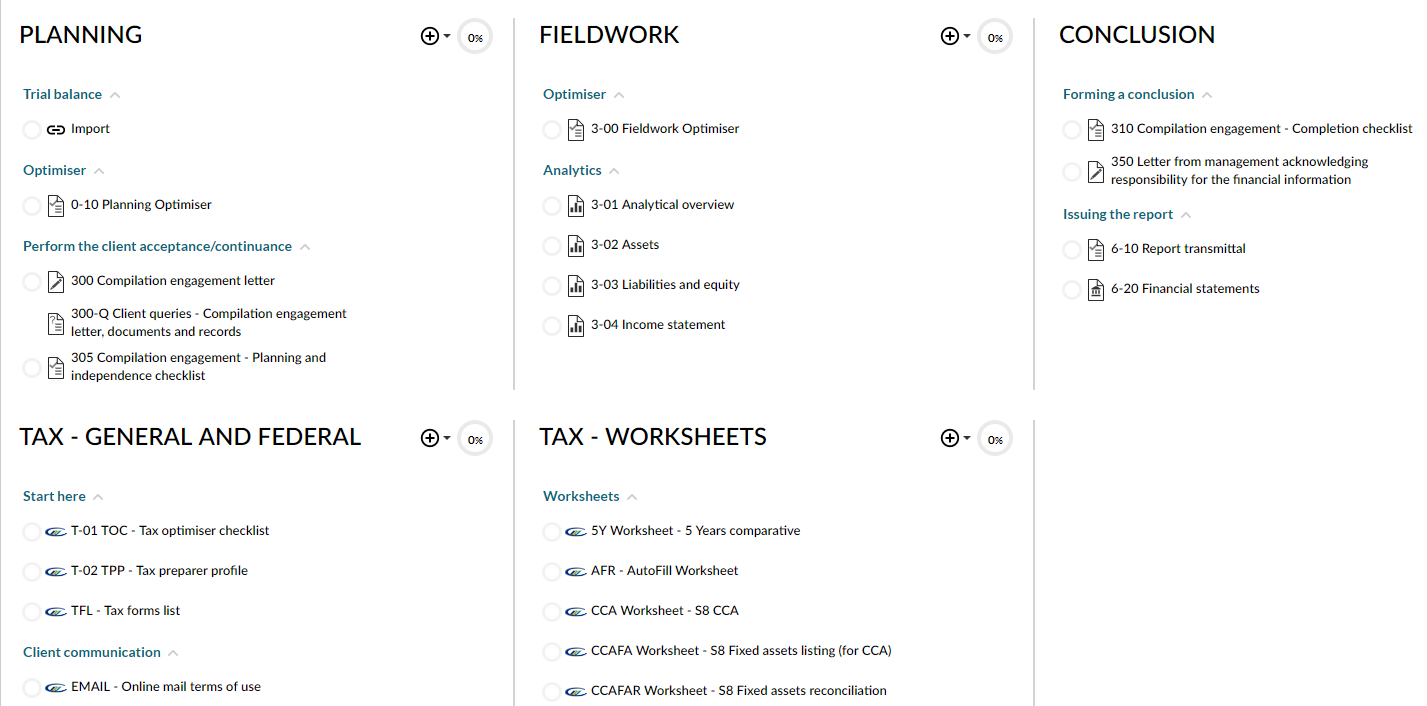
Contenido del CPA Canada PEG 2019
Hemos implementado las últimas actualizaciones de contenido de CPA Canada para los encargos de revisión y compilación, siguiendo los formularios de encargo de revisión alternativos. Aquí tiene una lista de los nuevos documentos que se han añadido.
- 3-30 Nóminas - procedimientos de revisión
- 3-20 Ingresos - procedimientos de revisión
- 3-25 Coste de las ventas - procedimientos de revisión
- 3-35 Otros gastos - procedimientos de revisión
- 6-00 Conclusiones de la revisión
A continuación figura una lista de los documentos que se han actualizado.
- 3-A Procedimientos de revisión de tesorería
- 3-B Procedimientos de revisión de las inversiones
- 3-C Procedimientos de revisión de las cuentas por cobrar
- 3-D Procedimientos de revisión del inventario
- 3-E Procedimientos de revisión de préstamos y anticipos
- 3-L Procedimientos de revisión de los gastos anticipados
- 3-N Otros procedimientos de revisión de inversiones
- 3-U Procedimiento de revisión del inmovilizado material
- 3-W Procedimientos de revisión de intangibles y fondo de comercio
- 3-AA Procedimientos de revisión del endeudamiento bancario
- 3-BB Procedimientos de revisión de los efectos a pagar y de la deuda bancaria
- 3-CC Procedimientos de revisión de cuentas por pagar y pasivos devengados
- 3-FF Procedimientos de revisión de los impuestos sobre la renta
- 3-GG Procedimientos de revisión de préstamos y anticipos por pagar
- 3-KK Procedimientos de revisión de la deuda a largo plazo
- 3-UU Procedimientos de revisión de la equidad
- 2-30-2 Consultas de los clientes - Cuestiones generales
- 5-10 Lista de control de finalización (Opinión modificada)
- Estados financieros con fines específicos (EFP)
- Contenido PEG - Carta de encargo
- Revisiones
- Recopilaciones
- Marco de información financiera
- Entender la entidad (2-03-1)
- Alcance del encargo
Problemas conocidos
El primer párrafo de la carta de representación de la dirección siempre está oculto.
Tipos de encargo afectados
Revisiones
Documentos afectados
5-25 Carta de representación de la dirección.
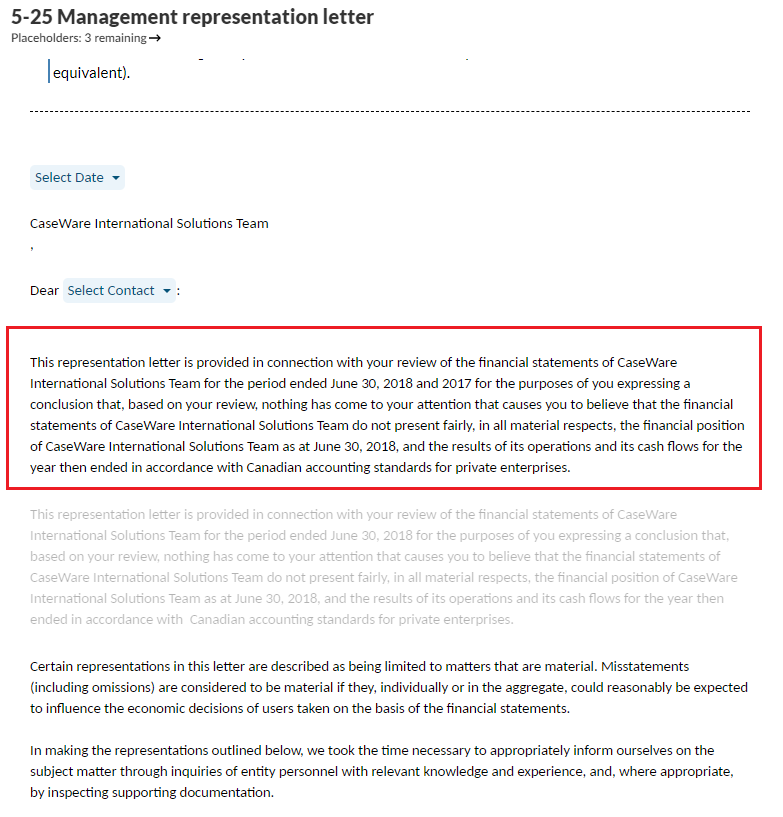
Solución
Hasta que resolvamos este problema, puede anular la configuración de visibilidad y mostrar el párrafo oculto.
-
Abra la carta de representación 5-25 Gestión.
-
Seleccione Más acciones (
 ) | Elementos ocultos.
) | Elementos ocultos. -
Si su encargo es por dos periodos:
-
Vaya al primer párrafo oculto.
-
Seleccione el icono Oculto (
 ) y, a continuación, seleccione Mostrar.
) y, a continuación, seleccione Mostrar.
-
-
Si su encargo es por un solo periodo:
-
Vaya al segundo párrafo oculto.
-
Select the Hidden icon (
 ), then select Show.
), then select Show.
-
Todos los elementos ocultos del documento se muestran en gris marcados con el icono Oculto (![]() ).
).

